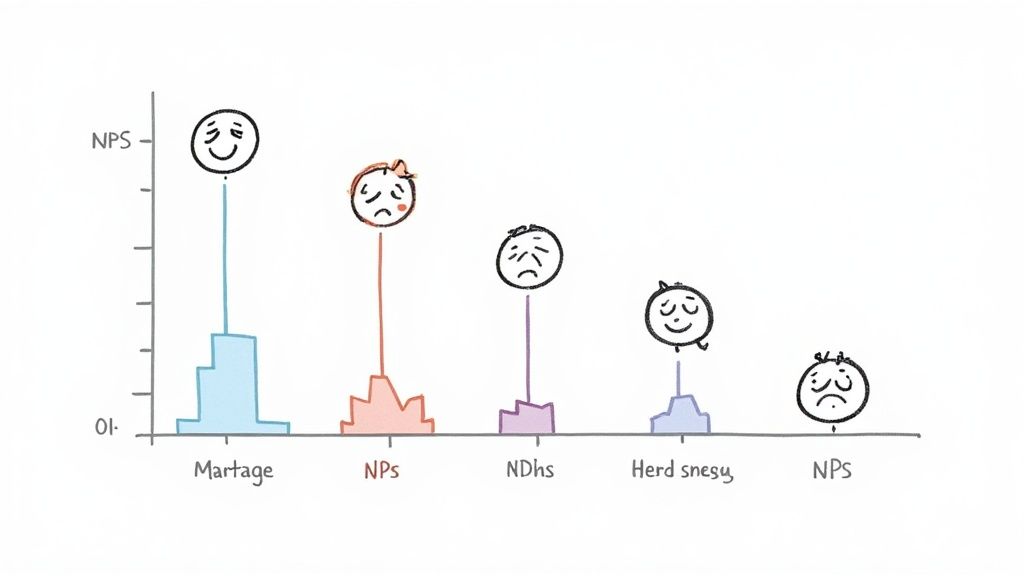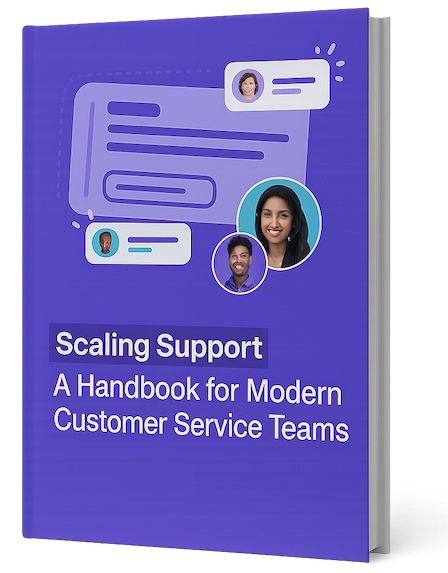Understanding the Strategic Power of Net Promoter Score

Customer loyalty drives business success, and the Net Promoter Score (NPS) helps companies track and improve it. This straightforward metric reveals how likely customers are to recommend your business to others. By understanding what NPS means and how to use it effectively, you can build stronger customer relationships that fuel sustainable growth.
Why NPS Matters
NPS stands out because it measures more than just satisfaction – it reveals true customer advocacy. When customers actively promote your business, it leads to real results like higher lifetime value, organic referrals, and enhanced brand reputation. For instance, research shows that companies with strong NPS scores tend to grow faster and earn higher profits, since loyal customers make repeat purchases and bring in new business through word-of-mouth.
The Genesis of NPS
The Net Promoter Score (NPS) emerged in 2003 when Frederick F. Reichheld published his book 'The Ultimate Question: Driving Good Profits and True Growth'. Working with Bain & Company and Satmetrix, Reichheld developed NPS as a simpler alternative to lengthy customer surveys. At its core is the "Ultimate Question": "On a scale of 0-10, how likely are you to recommend our product/service to a friend, colleague, or family member?" This single question proved remarkably effective at predicting future customer behavior including referrals, purchases and revenue. Learn more about NPS fundamentals The beauty of NPS lies in its simplicity – anyone in the organization can quickly grasp and act on the results.
Leveraging NPS for Strategic Advantage
Calculating your NPS score is just the beginning. The real value comes from using the data to drive improvements. Regular NPS analysis helps businesses identify problem areas, spot at-risk customers early, and develop targeted strategies to convert detractors into promoters. This data-driven approach leads to smarter decisions that enhance the overall customer experience.
For SupportMan users, NPS provides vital feedback on how support interactions impact loyalty. By incorporating NPS surveys into their workflows, support teams can get instant input on their performance and address issues proactively. The continuous feedback helps create a customer-focused culture that drives ongoing improvements and sustainable growth.
Mastering the Art and Science of NPS Calculation

NPS calculation gives you clear, actionable data about how your customers feel. This section shows you how to turn customer feedback into measurable insights that help improve loyalty and grow your business.
Categorizing Customer Responses
The first step is grouping responses to the "Ultimate Question": "On a scale of 0-10, how likely are you to recommend our product/service to a friend, colleague, or family member?" Customer scores fall into three key categories:
- Promoters (9-10): Your biggest fans who actively recommend your brand to others. These loyal customers fuel your organic growth.
- Passives (7-8): Satisfied but not enthusiastic customers who could switch to competitors. They rarely spread positive word-of-mouth.
- Detractors (0-6): Unhappy customers who may discourage others from using your product. They pose risks to retention and reputation.
Calculating Your NPS Score
The math behind NPS is straightforward. After categorizing responses, subtract the percentage of Detractors from the percentage of Promoters. For example, if you survey 150 customers and get 80 Promoters and 40 Detractors, that means 53% Promoters minus 27% Detractors equals an NPS of 26. Get more NPS benchmarks and data here. The final score ranges from -100 to +100, with anything positive considered good and scores above 50 viewed as excellent.
Ensuring Accuracy and Validity
Getting reliable NPS data requires careful attention to your survey process. A few key factors help maintain data quality:
- Consistent Survey Methodology: Use the same question format and scale each time to track trends accurately.
- Representative Sample: Survey a diverse mix of customers to get balanced feedback.
- Timely Data Collection: Run surveys at regular intervals and sync feedback with tools like Intercom to stay current.
Following these practices helps you confidently use NPS to benchmark performance, spot opportunities for improvement, and make smart decisions about your customer experience. Regular analysis of score trends gives you solid data to strengthen relationships with customers and expand your business.
Transforming Raw Scores Into Actionable Intelligence

Getting your Net Promoter Score is just the beginning. The real value comes from understanding what that number tells you about your business and using those insights to make meaningful improvements. This involves analyzing scores carefully, comparing to relevant benchmarks, and creating focused action plans.
Benchmarking Your NPS
To properly interpret your NPS, you need context. Benchmarking shows you how your scores compare to others in your industry. For instance, B2B companies typically see scores between 39 and 76, while B2C businesses range from 16 to 80. Different sectors have their own typical ranges – healthcare averages around 34, while tech services often hit 61. These comparisons help you understand where you stand and set reasonable goals. For more details, check out industry NPS benchmark statistics.
Identifying Trends and Patterns
Looking at how your NPS changes over time reveals important patterns. Rising scores point to growing customer loyalty, while declining numbers may signal problems that need attention. These shifts could stem from product updates, service changes, or competitive pressures. Regular trend monitoring helps you spot and address issues early.
Segmenting Your Data for Deeper Insights
Breaking down NPS data by customer groups, products, or service channels gives you a clearer picture of what's working and what isn't. You might find that certain products consistently earn better scores, or that specific customer segments report lower satisfaction. This focused analysis helps you target improvements where they matter most.
Communicating and Acting on NPS Data
Getting value from NPS requires clear communication and follow-through across your organization. Share key findings with everyone from frontline support teams to executives, adapting the message for each group. SupportMan users can connect NPS data to tools like Intercom and Slack, making it simple for teams to discuss feedback and work on solutions together. Keep tracking results and showing the business impact of NPS-driven changes. When you close the feedback loop with customers and celebrate wins, you build a culture focused on continuous improvement.
Building a High-Impact NPS Survey Program
Creating an effective NPS survey program takes more than just asking customers "the Ultimate Question." You need a thoughtful approach that gets solid response rates while providing clear insights you can act on. It starts with carefully planning the timing, distribution methods, and follow-up questions.
Timing and Frequency: Finding the Right Rhythm
When you send NPS surveys makes a big difference in getting quality feedback. Survey too often and customers get annoyed. Survey too rarely and you miss key input. For example, sending a quick survey right after someone buys something or contacts support helps capture their thoughts while the experience is fresh. Regular relationship surveys then show how loyalty changes over time. The key is finding a schedule that works for your business and customers.
Distribution Channels: Reaching Your Audience Effectively
Getting your survey in front of customers through the right channels is critical for high response rates. Different channels work better for different audiences and situations. You might use email, in-app messages, SMS, or social media depending on where your customers are most active. For instance, SupportMan users can easily add NPS surveys into their Intercom and Slack workflows, letting them gather feedback naturally through those platforms. This focused approach leads to better engagement and more useful insights.
Crafting Effective Follow-Up Questions
The main NPS question is just the start – good follow-up questions provide crucial details about why customers gave their score. Simple open-ended questions like "What could we do better?" help uncover specific pain points. When a detractor mentions long wait times, for example, you know exactly what needs fixing. This direct feedback points the way to meaningful improvements.
Maintaining Momentum and Data Quality
Running a successful NPS program takes ongoing work and attention to data accuracy. Keep an eye on response patterns, adjust your approach when needed, and stay consistent in how you gather feedback. This helps you spot trends and see if your improvements are working. Telling customers about the changes you've made based on their input shows you take their feedback seriously. This builds trust and encourages more responses in the future. Remember – NPS measurement is a continuous process, not a one-time project.
Let me know if you would like me to modify anything in the rewritten version.
Converting NPS Insights Into Business Growth

Getting a good NPS score is only part of the equation. The real value comes from using those insights to make meaningful improvements to your business. This means taking a practical approach to reviewing feedback, picking what to work on first, and building customer focus into your company's DNA.
Prioritizing Initiatives Based on NPS Feedback
After you have your NPS results, the next key step is figuring out what to improve first. Look closely at what your detractors and passives are saying to spot common problems. For instance, if you see lots of complaints about slow support response times, that's a clear signal to speed things up. Focus your efforts on fixing the issues that will make the biggest difference to customer happiness and your business results.
Allocating Resources Effectively
Once you know what needs fixing, you need to put your resources where they'll have the most impact. This could mean buying new tools, training your team, or making your internal processes work better. For example, if customers often complain about shipping delays, putting money into better delivery systems could significantly boost their experience. Smart resource allocation ensures your efforts target areas that will give you the best returns in terms of higher NPS and stronger business growth.
Measuring the Impact of Improvements
Making changes is just the beginning – you need to track if they're actually working. Keep surveying customers and watching your NPS trends. Also look at related numbers like how many customers leave, how much they spend over time, and how your revenue is growing. This data-driven approach helps you fine-tune what you're doing and stay on track.
Closing the Feedback Loop and Building Momentum
It's essential to close the loop with customers who give feedback, whether positive or negative. SupportMan users can connect NPS surveys with tools like Intercom and Slack to share feedback with the team and work together on solutions. For example, when someone gives negative feedback, sending them a personal message to acknowledge their concerns and explain what you're doing to fix them can help rebuild trust. Sharing success stories and celebrating improvements with your team helps create momentum and reinforces customer focus throughout your company.
By taking a methodical approach to analyzing NPS data, choosing what to work on first, using resources wisely, and measuring results, you can turn your NPS program from a simple metric into a real driver of business growth. This focus on customers builds loyalty, encourages referrals, and ultimately makes your business stronger.
Avoiding Critical NPS Implementation Pitfalls
Building an effective Net Promoter Score (NPS) program takes more than sending surveys. Success comes from careful planning, smart execution, and ongoing review to catch common issues before they impact your results.
Survey Design and Distribution: Getting it Right
Poor survey design can seriously skew your data. Leading questions like "How satisfied are you with our amazing service?" push respondents toward positive answers. Similarly, surveys that are too long lead to lower response rates. Your choice of distribution channels also matters – if customers don't use the channels you're sending surveys through, you won't get enough quality responses.
Interpretation Bias: Reading Between the Lines
Getting clean data is just the start. Many teams fall into the trap of focusing only on their overall NPS number without examining what's driving those scores. For instance, a high NPS might hide problems if most respondents are passive rather than true promoters. Teams also sometimes make the mistake of comparing their scores to industry benchmarks without accounting for their specific market position and customer base.
Lack of Action and Follow-Up: Closing the Loop
Data collection alone brings no value – you need to act on what you learn. When customers give feedback but see no changes, they lose faith in the process. For example, if multiple detractors point out long support wait times but nothing improves, those customers are likely to leave. This shows why it's crucial to not just gather feedback, but use it to make real improvements. You also need to tell customers what changes you've made based on their input.
Maintaining Program Integrity: Long-Term Success
Running a strong NPS program requires ongoing effort. Sporadic surveying gives you outdated information and misses shifts in customer sentiment. Instead, survey regularly – whether quarterly or monthly – to stay current. You also need to integrate NPS data into your daily work, from reviewing scores in team meetings to connecting NPS with your CRM to personalize customer interactions.
SupportMan works smoothly with tools like Intercom and Slack to help you gather, analyze and act on NPS feedback while avoiding these common issues. Our platform lets you quickly spot problems, improve your support approach, and turn raw NPS numbers into clear steps for growth. Try SupportMan's simple setup with a no-commitment free trial today! Start your free SupportMan trial now!


